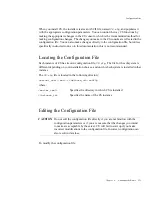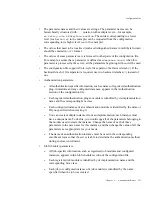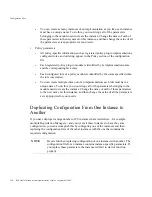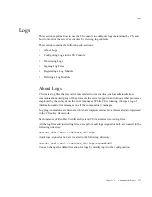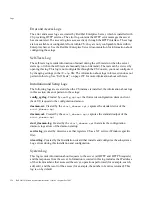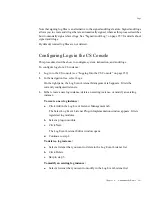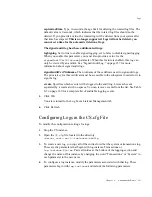
Configuration Files
Chapter 8
Administrative Basics
253
•
The parameter names and their values are strings. The parameter names can be
hierarchically structured with
'.'
notation with multiple levels—for example,
ca.Policy.rule.RSAKeyRule.maxSize
. The entries corresponding to a lower
level (such as
Policy
in the example) can be requested from the configuration
corresponding to its higher level (
ca
in the example).
•
The values that need to be localized (such as distinguished names in multibyte format)
should be entered in
utf8
format.
•
The values of some parameters are referenced to other parts of the configuration file.
For example, assume that a parameter is defined as
subsystem.id=ca
; when this
parameter is processed by the server, all the parameters beginning with
ca
will be used.
•
The configuration file supports Unix-style file separator, the forward slash (/). If the
backward slash (\) file separator is required, use two backward slashes (\\) instead of
one.
•
Authentication parameters:
❍
All authentication-specific information, such as names of registered authentication
plug-in modules and any configured instances, appears in the Authentication
section of the configuration file.
❍
Each registered authentication plug-in module is identified by its implementation
name and the corresponding Java class.
❍
Each configured instance of an authentication module is identified by the name or
ID you specified when creating it.
❍
You can create multiple instances from an implementation; each instance must
have a unique name. To do this, you would copy all of the parameters belonging to
the module used to create the instance. Change the name of each of these
parameters to the new name for this instance, and then change the value of all the
parameters as is appropriate for your needs.
❍
The name of an authentication instance must be used in the corresponding
enrollment form so that the server is able to determine the authentication method
during end-user enrollment.
•
Job Scheduler parameters:
❍
All job-specific information, such as registered job modules and configured
instances, appears in the Job Scheduler section of the configuration file.
❍
Each registered job module is identified by its implementation name and the
corresponding Java class.
❍
Each job (or configured instance of a job module) is identified by the name
specified when the job was created.
Summary of Contents for CERTIFICATE 7.1 ADMINISTRATOR
Page 1: ...Administrator s Guide Red Hat Certificate System Version7 1 September 2005 ...
Page 22: ...22 Red Hat Certificate System Administrator s Guide September 2005 ...
Page 128: ...Cloning a CA 128 Red Hat Certificate System Administrator s Guide September 2005 ...
Page 368: ...ACL Reference 368 Red Hat Certificate System Administrator s Guide September 2005 ...
Page 460: ...Constraints Reference 460 Red Hat Certificate System Administrator s Guide September 2005 ...
Page 592: ...CRL Extension Reference 592 Red Hat Certificate System Administrator s Guide September 2005 ...













